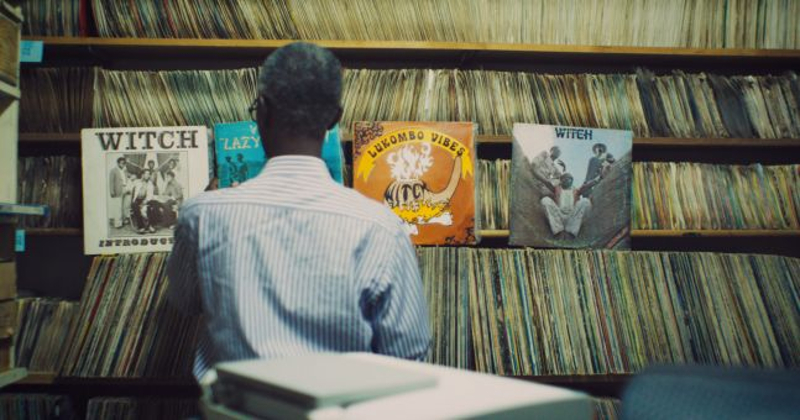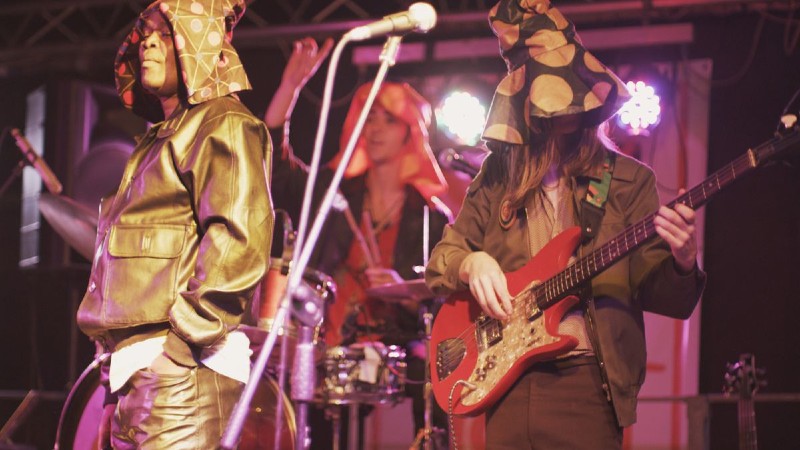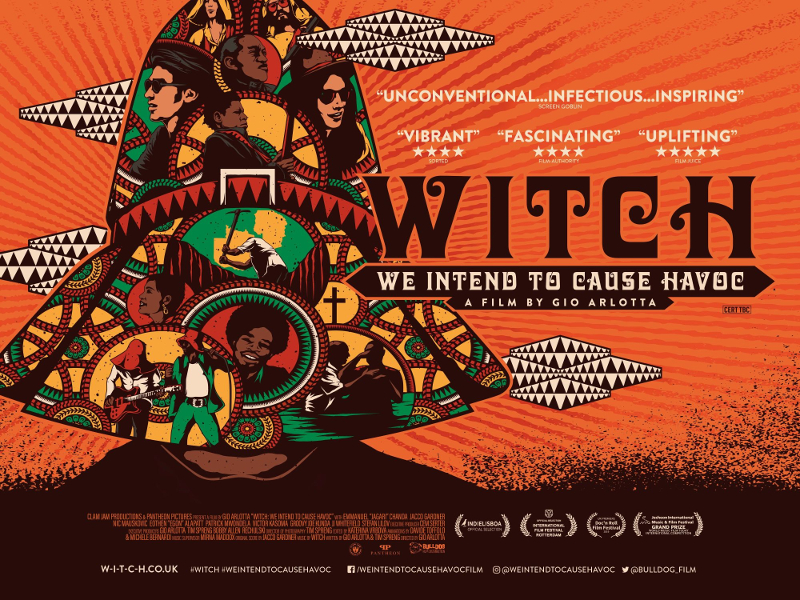Director – Gio Arlotta – 2019 – Italy, Czech Republic – Cert. 12 – 98m – English Language
***1/2
Winsome if shallow documentary follows survivors from Zambia’s seventies music Zamrock phenomenon as they reform and tour Europe – in cinemas and on VoD from Friday, July 2nd
On the verge of a pan-African trip that will take the narrator through Zambia alongside bassist / vocalist Jacco Gardner and drummer Nic Mauskoviç, intensive research reveals the Zamrock phenomenon of the 1970s which mixed traditional African rhythms with psychedelic rock music of which the band WITCH was the leading proponent. The name later turned in to an acronym for We Intend To Cause Havoc at the suggestion of the band’s then graphic designer. Sadly, many of the original band members are now dead following the AIDS crisis which hit the African continent pretty hard.
At Zanis, the state-owned television company, we enter a 16mm archive that hasn’t been opened for 17 years because the room key had been lost. The music section reveals footage of James Brown performing in Africa but nothing of WITCH even though apparently they were all over broadcast TV at the time – much of what was taped of them may well have been recorded over by footage of President Kaunda on his latest walkabout.

However, talking to people around Zambia, everyone opens up enthusiastically about Zamrock and WITCH. Lead singer Jagari (Emmanuel ‘Jagari’ Chanda) is described as leaping around the stage energetically.
When the narrator finally meets Jagari, he finds what he describes as a seventies rock star battling with his present day role as a religious devotee, “between what felt right and what had been indoctrinated”. The problem here is that while the filmmakers clearly know their music, they don’t seem to have much interest in religion or Christianity so numerous potential seams of information remain untapped.
Jagari talks about the various band members who died, including Chris who never drank like Jagari himself did. Many of them died from AIDS. Jagari considered becoming a soldier, but never did so because he would have had to cut his Afro. When he tracks down George ‘Groovy Joe’ Kunda, the first WITCH drummer, their reunion is cheerful. Both have long since lost their Afros. “You can’t always get what you want,” admits Jagari, referencing the Rolling Stones vocalist on whose name his moniker is based, “but at least two of us are still alive.”

Zamrock was inspired by the 1960s British invasion bands to the US who were in turn inspired by the Chicago Blues musicians, many of whom had emigrated North from the cotton plantations. Jagari clearly struggles with the fact that his own opportunities in life – or more accurately the lack of them – seem to have hindered his musical career.
When we see Jagari at the start, he’s earning a living spending two weeks or so at a time at an amethyst mine to the South of Lusaka. He constantly whether it’s “God’s will” that he should be mining – he never states that this seems unfair while his overall cheerfulness is disarming. However, he clearly feels much more at ease making or teaching music and from what we see and hear he has quite a talent for it, which suggests his time spent mining is a terrible waste.
Briefly seen here, Victor Kasoma of rival Zamrock outfit The Oscillations was widely regarded as Zambia’s Hendrix and talks about doing anything to make his guitar sound interesting, like play it with his teeth.
At Lusaka’s DB Studios, Peter Musungilo, the engineer on WITCH’s Lazy Bones!! album goes through shelves of LP records to pull out the debut WITCH album, eventually putting some four albums on display for the camera (which in the next shot pans past five). He also unearths what the geeky narrator refers to as “the lost” Oscillations album, complete with Victor Kasoma’s pic on the back cover. He proudly displays the studio’s old 1970s valve recording equipment. “Switch it on and it can take some time to warm up”, says Peter.

Emmanuel Kapembwa is the Zamrock tailor responsible for the huge, face-covering hats members of WITCH would wear on stage, which according to Jagari would allow him to hide from the crowd during performances and follow his feelings inward.
We briefly meet Jagari’s wife Grace Mporokoso Chanda, a pastor. “When I watched him perform he just took my heart,” she says simply. She was so different from all the other women he met as a musician. Her brothers meanwhile thought she was picking someone beneath her.
She invokes religion, saying that “God’s plans are not our plans” as images appear of their local church worship – lots of singing, dancing, African rhythm and Hallelujahs plus a clean looking gospel choir with the music on the soundtrack blanked out by light, high-pitched monotone, possibly in an attempt to imply something otherworldly (although I’d hate to pin down exactly what spiritual values if any that’s supposed to indicate – it doesn’t feel like whoever cut this together has any idea beyond a tasteful transition to the next scene).
Grace talks about Jagari’s being unjustly accused of a crime which had to do with some import/export deals in which his brother was involved. The accusation cost him his job. She meanwhile had “come to Jesus” and soon after, Jagari joined the Pentecostal church his wife attended where he was not only discouraged from playing “that” music, but also to use his talents. He talks about “a need to be sober to sort things out” but doesn’t expand much further on his previous lifestyle which, reading between the lines, may have been something of a mess.

The filmmakers, in awe of meeting “the Paul McCartney of Africa” – an unconvincing model for the head of a psych band if ever there was one – never really probe their subject for answers. Their interest lies rather in putting Jagari together with former bandmates such as Patrick Mwondela who emigrated to England and Braintree, Essex and was involved in WITCH after Jagari’s departure and the demise of Zamrock in the early 1980s when the band’s style had morphed into disco.
Thus, for the first time in 40 years, Jagari and a new version of WITCH featuring a mixture of Zambian and European musicians are gigging again, touring Europe.

A few brief real time animation sequences give both an impression of the atmosphere of the band playing live and abstract psychedelic imagery (such as the words We Intend To Cause Havoc appearing one after the other), injecting vivid colour into the already pleasant on the eyes African palette. The footage of the band playing in European gigs and the album excerpts used on the soundtrack are nonetheless impressive. However, you can’t help but feel that Arlotta’s documentary, enjoyable though it is, barely skims the surface of its truly fascinating subject.
WITCH We Intend To Cause Havoc is out in cinemas and on VoD in the UK from Friday, July 2nd.
Trailer:
